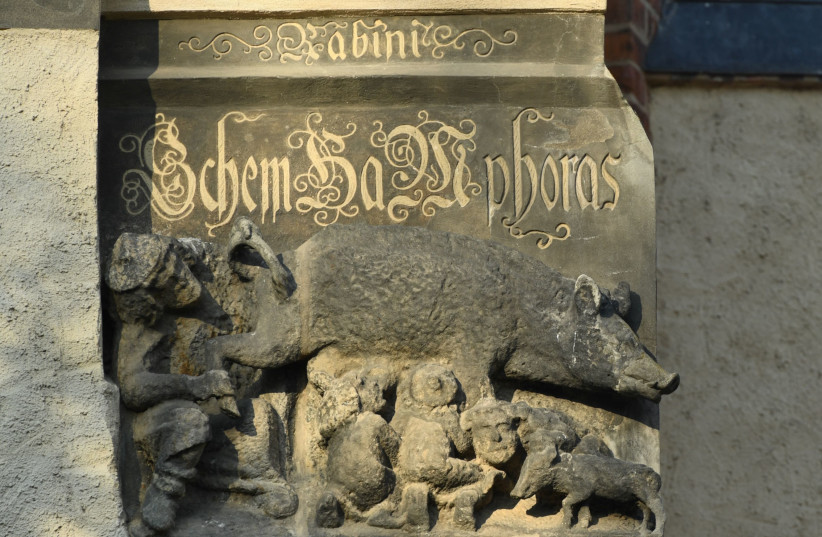Antisemitic medieval sculpture in German church not removed, but covered
A medieval antisemitic sculpture on the capital of a column in St. Peter and Paul cathedral in Brandenburg an der Havel in Germany will not be removed, church officials stated on Monday.
The sculpture of a “Judensau” (Jew sow) which is carved into a column about two meters above ground will instead be permanently covered up, the Evangelical Church Berlin-Brandenburg-Silesian Upper Lusatia announced on its website.
Removal deemed impossible
The removal of the sculpture and its exhibition accompanied by historical explanation elsewhere were discussed, but deemed impossible for structural reasons and because of the sculpture’s problematic teracotta material, said Bishop Christian Staeblein, who is chairman of the church’s supervisory board.
It was then decided to enact “ a form of visual elimination”. This way the sculpture will still be available for historical engagement with this medieval form of Jew-hatred, according to Staeblein.
Staeblein clarified that there was “neither any doubt about the anti-Semitic statement that emanates from this relief, nor about the guilt of the churches for actively promoting hatred of Jews and anti-Semitism.” He added that he saw it as his task now “to deal with this heavy, shameful legacy in a conscious and appropriate manner.”
![A thirteenth century anti-Semitic sculpture is displayed at St. Marien church in Wittenberg, Germany, January 24, 2020. A court is expected to rule on a motion seeking the removal of the 700-year-old sculpture known as “Judensau” or Jew pig. It is one of around 20 such relics from the Middle Ages th (credit: ANNEGRET HILSE / REUTERS) A thirteenth century anti-Semitic sculpture is displayed at St. Marien church in Wittenberg, Germany, January 24, 2020. A court is expected to rule on a motion seeking the removal of the 700-year-old sculpture known as “Judensau” or Jew pig. It is one of around 20 such relics from the Middle Ages th (credit: ANNEGRET HILSE / REUTERS)]() A thirteenth century anti-Semitic sculpture is displayed at St. Marien church in Wittenberg, Germany, January 24, 2020. A court is expected to rule on a motion seeking the removal of the 700-year-old sculpture known as “Judensau” or Jew pig. It is one of around 20 such relics from the Middle Ages th (credit: ANNEGRET HILSE / REUTERS)
A thirteenth century anti-Semitic sculpture is displayed at St. Marien church in Wittenberg, Germany, January 24, 2020. A court is expected to rule on a motion seeking the removal of the 700-year-old sculpture known as “Judensau” or Jew pig. It is one of around 20 such relics from the Middle Ages th (credit: ANNEGRET HILSE / REUTERS)
 A thirteenth century anti-Semitic sculpture is displayed at St. Marien church in Wittenberg, Germany, January 24, 2020. A court is expected to rule on a motion seeking the removal of the 700-year-old sculpture known as “Judensau” or Jew pig. It is one of around 20 such relics from the Middle Ages th (credit: ANNEGRET HILSE / REUTERS)
A thirteenth century anti-Semitic sculpture is displayed at St. Marien church in Wittenberg, Germany, January 24, 2020. A court is expected to rule on a motion seeking the removal of the 700-year-old sculpture known as “Judensau” or Jew pig. It is one of around 20 such relics from the Middle Ages th (credit: ANNEGRET HILSE / REUTERS)The sculpture dates from the 13th century, measures around 22 by 55 centimeters and shows a suckling pig with a human face and a Jewish headgear.
It is not placed in the church building itself but in the cloister of the adjacent monastery building. The sculpture was meant to reming the monks of the cathedral to live a sin-free life.
Other antisemitic sculptures
Images mocking Jews and Judaism and encouraging anti-Semitic violence have been displayed throughout Europe since the early Middle Ages. In a time when literacy was uncommon, these images were the political cartoons and posters of the age, and the ridicule and carnage they promoted was both routine and government sanctioned.
Maybe the most famous example of a “Judensau” is the one in Wittenberg, Germany. The Wittenberg stone carving is one of about two dozen similar sculptures from the Middle Ages that still feature on churches around Germany and elsewhere in Europe.
This Wittenberg Judensau (1305) shows Jews suckling at the sow’s teat while another feeds at the animal’s anus. Above it appears an inscription in Latin letters, “Rabini Shem hamphoras.”The phrase is gibberish, but refers to the Hebrew words “Shem HaMephorash,” a term for one of the hidden names of God.
Last year, Germany’s top court ruled that the sculpture can stay on the facade of a church in the eastern German town, rejecting an appeal by a Jewish plaintiff who has for years argued it is an insult to all Jews.
JTA and Reuters contributed to this story.





Comments are closed.